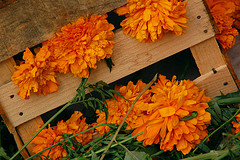The traditional Mexican holiday of Day of the Dead or Día de los Muertos has become more prominent in recent times. Why is there a celebration for death? Aren’t we supposed to be sad? Is the Day of the Dead related to Halloween? Why don’t they combine both holidays? What is the relation of the skeleton character or skull with the Day of the Dead?
Read these 13 cool and interesting facts about the Day of the Dead to get the answers to your questions and also watch this video from BBC that presents some of the traditions of the indigenous celebration of the Day of the Dead.

The date of the Day of the Dead
1. The Day of the Dead has its origins from pre-Hispanic civilizations from 2,500 to 3,000 years ago, long before the Spaniards conquered Mexico. That celebration took place in the 9th month of the Aztec calendar (about August in today’s calendar) and lasted the whole month.
2. The Day of the Dead actually takes place on two days. The Day of the Dead is on November 2nd, but the celebration starts from November 1st.
In most regions of Mexico, November 1st is to honor children and infants, whereas deceased adults are honored on November 2nd. This is indicated by referring to November 1st mainly as Día de los Inocentes or Day of the Innocents but also as Día de los Angelitos or Day of the Little Angels and November 2nd as Día de los Muertos or Día de los Difuntos or Day of the Dead. –Source: Wikipedia
3. The Day of the Dead coincides with the Catholic celebrations of the Día de los Santos or All Saints’ Day (November 1st) and the Día de los Fieles Difuntos or All Souls’ Day (November 2nd). –Source: Catholic.net
The Day of the Dead Traditions
4. Indigenous people from Mexico believe the soul is eternal and that it can travel back and forth from this world and the next. The celebration of the Day of the Dead is based on the belief that the souls of their loved ones will come back and visit them. –Source: Discovery
 5. Day of the Dead traditions vary among regions and villages. The way that The Day of the Dead is celebrated today is a blend of the indigenous civilization traditions with the Catholic religion inherited from Spain.
5. Day of the Dead traditions vary among regions and villages. The way that The Day of the Dead is celebrated today is a blend of the indigenous civilization traditions with the Catholic religion inherited from Spain.
6. One of the most important traditions is the set up of an altar in memory of the deceased where the four elements of nature, water, wind, fire (candles) and earth (flowers) are represented. The altar or offerings might include the favorite food of the loved one, fruit, bread or pumpkin. –Source: Discovery Fantastic Festivals of the World Mexico
7. Mexican cempasúchitl (marigold) is the traditional flower used to honor the dead. It is yellow like the sun and represents life and hope. They are used in the altars and graveyards. –Source Wikipedia
8. Prior to the Day of the Dead, families embellished the tombs of their loved ones for a vigil during the night. The vigil lasts until dawn and includes music, food, and drinks at the graveyard.
9. UNESCO declared the indigenous festivity dedicated to the dead as an Intangible Cultural Heritage of Humanity. -Source: Unesco.org
The Skeleton and skulls is the symbol of the dead
10. In the pre-Hispanic era, skulls were commonly kept as trophies and displayed during the rituals to symbolize death and rebirth. –Source: Wikipedia
11. Calaveras (skulls) are short poems mocking epitaphs of friends, describing interesting habits and attitudes or funny anecdotes. This custom originated in the 18th or 19th century. The caravelas literarias or literature skulls originated in the 19th century as a form of illustrations of important personalities and politicians of the time as skeletons that kept their features so they were recognizable. The illustrations included a short epitaph-style poem.
12. Candy skulls made of sugar are part of the Day of the Dead tradition. Placing the calaveritas or little skulls in the altars as an offering is a custom from urban areas. In the rural areas, the return of the dead is celebrated placing traditional dishes. –Terra.com
13. The most iconic skeleton is La Catrina, originally named La Calavera Garbancera, created by Mexican artist José Guadalupe Posada in the 1800’s. –Source: Xicoinc.org
Check out these other Mexican Culture articles.
